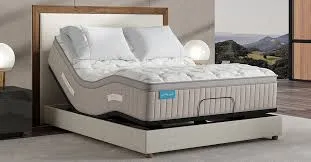Adjustable beds have become increasingly popular in recent years, offering a customisable sleeping experience that can enhance comfort and provide relief from various health issues. These beds allow users to elevate their heads, feet, or both, catering to personal preferences and medical needs. But when it comes to choosing a mattress for an adjustable bed, the question often arises: can any mattress be used on an adjustable base? Let’s delve into this topic to understand what makes a mattress compatible and how to select the right one for your adjustable bed.
Understanding the Compatibility Requirements
Not all mattresses are suitable for adjustable beds. The ability to bend, flex, and conform to the various positions of an adjustable base is a crucial factor. Traditional innerspring mattresses, for instance, are often too rigid to work effectively with these bases. The components of such mattresses, including the coil support system, are not designed for repeated bending and may lead to premature wear or even damage.
On the other hand, modern mattresses made from materials such as memory foam, latex, or hybrid constructions are typically designed to be more flexible. These materials can accommodate the contours and adjustments of the base without compromising comfort or structural integrity. For example, a helix mattress, known for its adaptability and support, is an excellent choice for adjustable beds. Its hybrid design combines memory foam with pocketed coils, providing the perfect balance of comfort and durability.
Factors That Make a Mattress Suitable for Adjustable Beds
Flexibility
One of the most critical factors for compatibility is flexibility. A mattress must be able to bend and move with the adjustable base without causing discomfort to the user or damaging the mattress itself. Memory foam and latex are particularly flexible materials that work well with these beds, as they can easily conform to different positions without losing their supportive properties.
Thickness
The thickness of the mattress is another important consideration. While thicker mattresses may seem more luxurious, they can pose challenges when used with an adjustable base. A mattress that is too thick may struggle to bend or flex adequately, leading to discomfort or mechanical strain on the bed frame. Ideally, mattresses for adjustable beds should be between 8 to 12 inches thick. This thickness provides the right balance of support, comfort, and flexibility.
Durability
Using an adjustable base involves frequent changes in position, which can put additional strain on the mattress. Therefore, durability is a key factor when selecting a mattress. High-quality materials like those found in a helix mattress ensure that the mattress can withstand the wear and tear associated with an adjustable bed without losing its supportive or comfort features.
Can You Use Your Existing Mattress?
If you already own a mattress, you might wonder whether you can pair it with an adjustable bed. The answer depends on the type of mattress and its construction. Innerspring mattresses, particularly those with interconnected coils, are generally unsuitable because they lack the flexibility required for adjustable bases. However, pocket coil mattresses, which feature individually wrapped coils, may work if they are not too thick.
Foam mattresses, such as memory foam or latex, are more likely to be compatible with adjustable beds due to their inherent flexibility. If you’re unsure, check the manufacturer’s guidelines to see if your mattress is rated for use with adjustable beds. For those looking to upgrade, investing in an adjustable bed with a mattress included can simplify the decision-making process and ensure compatibility.
Benefits of Using a Compatible Mattress
Pairing an adjustable bed with a compatible mattress offers numerous benefits, ranging from enhanced comfort to improved health outcomes. When the mattress and base work seamlessly together, users can fully enjoy the advantages of adjustable sleeping positions. Here are some key benefits:
Enhanced Comfort
A compatible mattress can conform to the body’s shape and support the spine in any position, reducing pressure points and providing more restful sleep. Whether you prefer to elevate your head for reading or raise your legs for circulation, the right mattress ensures maximum comfort.
Better Sleep Quality
Sleep quality is crucial for overall well-being, and an adjustable bed paired with the right mattress can significantly enhance it. Features like memory foam’s body contouring or latex’s natural resilience contribute to a more restorative sleep experience, especially when combined with the adjustable bed’s custom settings.
Health Benefits
Many users turn to adjustable beds to alleviate specific health issues, such as acid reflux, snoring, or back pain. A compatible mattress ensures that these conditions are addressed effectively. For example, memory foam mattresses can reduce pressure on the lower back, while latex options provide excellent spinal alignment.
The Role of Mattress Materials
Different mattress materials interact with adjustable bases in unique ways. Here’s a closer look at how the most common materials perform:
Memory Foam
Memory foam is highly flexible and can easily conform to the curves of an adjustable bed. Its ability to distribute weight evenly and relieve pressure points makes it a popular choice for users seeking enhanced comfort and support.
Latex
Natural and synthetic latex mattresses are known for their durability and flexibility. They provide a responsive feel and excellent support, making them ideal for adjustable beds. Additionally, latex mattresses are resistant to dust mites and allergens, offering a healthier sleeping environment.
Hybrid
Hybrid mattresses, such as the helix mattress, combine the benefits of memory foam and innerspring coils. These mattresses offer the flexibility and contouring of foam with the support and durability of coils, making them a versatile choice for adjustable beds.
Common Misconceptions About Adjustable Bed Mattresses
Any Mattress Will Work
One of the most prevalent myths is that any mattress can be used on an adjustable bed. As discussed, this is not the case. Compatibility depends on factors like flexibility, thickness, and durability, which vary across mattress types.
Adjustable Beds Damage Mattresses
Some people worry that using an adjustable bed will damage their mattress. While this can be true for non-compatible mattresses, those designed for adjustable bases are built to handle the movement without compromising their longevity.
They’re Only for Medical Use
Adjustable beds were once primarily associated with medical settings, but this perception has changed. Today, they are widely used in homes for their comfort and versatility. Paired with the right mattress, they can cater to anyone’s lifestyle needs.
Tips for Choosing the Right Mattress
When shopping for a mattress for your adjustable bed, consider the following tips:
- Test for Flexibility: Ensure the mattress can bend and conform to different positions.
- Check Manufacturer Guidelines: Look for mattresses specifically labelled as compatible with adjustable bases.
- Prioritise Quality: High-quality materials will ensure durability and comfort.
- Opt for a Trusted Brand: Reputable brands like those offering adjustable beds with mattress bundles can provide peace of mind regarding compatibility and performance.
Final Thoughts
While not all mattresses are suitable for adjustable beds, selecting the right one is essential for maximising the benefits of these versatile bases. Memory foam, latex, and hybrid mattresses are among the best options, offering the flexibility, durability, and comfort needed to enhance your sleep experience. By understanding compatibility requirements and investing in a high-quality mattress, you can transform your adjustable bed into a personalised haven of comfort and support.









